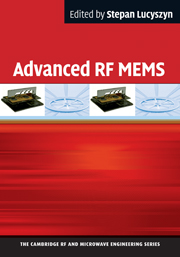Book contents
- Frontmatter
- Dedication
- Contents
- List of Contributors
- Preface
- List of Abbreviations
- 1 Introduction
- 2 Electromechanical modelling of electrostatic actuators
- 3 Switches and their fabrication technologies
- 4 Niche switch technologies
- 5 Reliability
- 6 Dielectric charging
- 7 Stress and thermal characterisation
- 8 High-power handling
- 9 Packaging
- 10 Impedance tuners and tuneable filters
- 11 Phase shifters and tuneable delay lines
- 12 Reconfigurable architectures
- 13 Industry roadmap for RF MEMS
- Author biographies
- Index
- References
8 - High-power handling
Published online by Cambridge University Press: 05 February 2014
- Frontmatter
- Dedication
- Contents
- List of Contributors
- Preface
- List of Abbreviations
- 1 Introduction
- 2 Electromechanical modelling of electrostatic actuators
- 3 Switches and their fabrication technologies
- 4 Niche switch technologies
- 5 Reliability
- 6 Dielectric charging
- 7 Stress and thermal characterisation
- 8 High-power handling
- 9 Packaging
- 10 Impedance tuners and tuneable filters
- 11 Phase shifters and tuneable delay lines
- 12 Reconfigurable architectures
- 13 Industry roadmap for RF MEMS
- Author biographies
- Index
- References
Summary
Introduction
RF MEMS are key enabling components within a number of applications where the level of RF power can reach significant values (e.g. above 1 W). Examples include reconfigurable matching networks, for optimised power-added efficiency (PAE) amplifiers; tuneable or switchable filters; and reconfigurable routing networks that can include switching matrices. Contrary to non-RF MEMS technologies that have already reached industrial maturity (e.g. pressure sensors accelerometers, etc.), the operational principle of RF MEMS devices is, in general, based on physical contact (be it ohmic or capacitive), between constitutive mechanical parts, and are characterised by the coexistence of biasing and RF signals. Exceptions to this include variable inductors and RF-coupled cantilever inverted-microstrip filters. This is unique to RF MEMS and becomes of increasing importance as the RF power level increases. The RF power transfer through the device strongly depends on the quality of the physical contacts, with the associated RF voltages and RF currents affecting the electromechanical action – by yielding unwanted phenomena (e.g. self-actuation, stiction and contact wearing). Moreover, other and more conventional related effects (e.g. self-heating and electromigration), as shown in Fig. 8.1, must be considered. With device sizes of approximately a few square millimetres and made of suspended movable metal and/or dielectric parts, it becomes evident that RF power-handling optimisation must be based on a comprehensive modelling approach, covering the underlying coupled thermo-electromechanical phenomena, and be driven by innovative design and technological approaches. Because of this complex scenario, the topic of RF power handling has become the subject of great interest in the research community and one of the top priorities for industrial applications. In this chapter, the state-of-the-art will be surveyed from the perspectives of the fundamental related phenomena, such as electromigration, self-heating and self-actuation. Throughout, the focus will be on capacitive switches, varactors and metal contact switches.
- Type
- Chapter
- Information
- Advanced RF MEMS , pp. 205 - 231Publisher: Cambridge University PressPrint publication year: 2010

